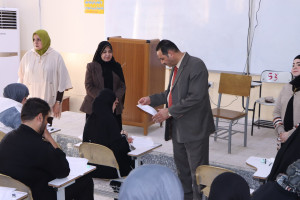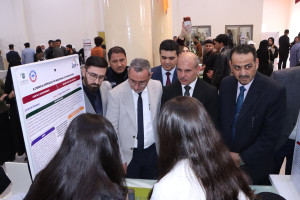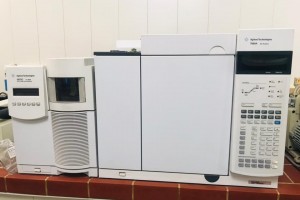
The College of Education for Pure Sciences, Department of Life Sciences at the University of Basra, discussed a master’s thesis
Diagnosis and seasonal distribution of some species of the mosquito family Culicidae in Basra Governorate
The letter presented by the researcher (Wood Hamid Abd) included the diagnosis of some of the
Types of the mosquito family Culicidae in Basra governorate during the period from September 2020 to August 2021 in the northern station of Basra, which included stations in Al-Qurna and Al-Madina and the Basra city center station as fixed sites for sampling, in addition to other stations in Al-Haritha, Abi Al-Khasib and Karma Ali as temporary sites as the study included Identification of larvae, pupae and adults of nine species of the mosquito family, including two species belonging to Anophelinae within the genus Anopheles and seven species belonging to Culicinae within four genera (Aedes, Culex, Culiseta and Uranotaenia).
And the proximity of Uranotaenia to the type cf. unguiculata, which shares some characteristics with it, such as the presence of a sclerotic plate in the larva and also the shape of the wing, and it is believed that it is a new record for the Iraqi Fauna and in the province of Basra in particular. Culiseta longiareoata and Uranotaenia cf. unguiculata by using the scanning electron microscope (SEM) technique, as it was found that there are subtle phenotypic differences by examining pectin teeth, comb scales, palatal brush filaments, and some spiky siphon patterns.
By studying the seasonal occurrence of larvae of the mosquito family, the results showed that the species Aedes caspius had the highest occurrence rate among the species, reaching 16.52 larvae/month, while the species Uranotainia cf. unuiculata had the lowest rate and reached 1.05 larvae/month, and the city station recorded the highest rate of species presence, reaching 11.34 larvae/month, while the lowest rate of species was in the Basra city center station and amounted to 4.55 larvae/month. Month . While the lowest rate was 0.32 larvae/month in July.
Some environmental factors were measured in the study sites, which are air and water temperature, dissolved oxygen, salinity, pH and their effects on the rate of aquatic larvae presence. The highest average air and water temperature was recorded during the month of July, reaching 43.56 °C and 33.50 °C, respectively, while it was lower. averages of 16.35 °C and 13.01 °C respectively in January, and the study showed that the highest dissolved oxygen rate was in the city station and reached 5.59 mg / l, while the lowest rate was recorded in the center of Basra governorate and reached 5.22 mg / l. The pH rates are close in the study stations, and they are neutral to light basic, as their rates ranged between 7-8.17. It was also noted that the highest rate of salinity was in the Basra city center station and amounted to 6.69 dSi/m, while the lowest rate was 5.06 dsi/m at the station. The city was the most influential factor in the monthly presence rate of larvae is temperature.
The message aims to
Collecting the aquatic stages of mosquitoes (eggs, larvae and pupae) and isolating them from the aquatic environment, as well as complete from the same incomplete stages collection places to know the prevalence of mosquito species and their presence in the areas of Basra Governorate.
Diagnosing incomplete and complete stages by adopting special taxonomic keys, drawing samples using Lucida camera and photographing them with a digital camera.
And the use of scanning electron microscopy (SEM) technique for the incomplete instars, especially the fourth larval instar, to confirm the phenotypic diagnosis because the current study is the first diagnostic study for mosquitoes with this technique in Iraq.
Estimating the seasonal presence of larval instars Studying some physical and chemical properties of the aquatic environment such as temperature, salinity, pH and the amount of dissolved oxygen and recording their effect on the seasonal presence of larval instars.
Message inferred
The presence of a clear diversity in the types of mosquito family diagnosed and spread in Basra Governorate.
The predominance of species of the mosquito family only, especially the type Aedes Caspius and other species of the genus Culex. Especially the type Culex quinquefasciatus in the city station.
The scanning electron microscope technique contributes to confirming the diagnosis of the larval stages through the presence of a clear heterogeneity between some structures such as the metatarsal scales, pectin teeth, the filaments of the palatal brush of the mouthbrush, and some surface patterns of the siphon, which are important for classification in the scanning electron microscope.
4- There are two seasonal peaks for the spread of the larval conditions, the first in the fall and the other in the spring, with high rates of occurrence.
5- The water temperature factor is perhaps one of the most important factors that affect the presence of the water phases of mosquitoes (larvae) compared to the other factors.
Recommended letter
Conducting more taxonomic and diagnostic studies for the mosquito family, especially at the level of other southern governorates, and making checklists of previously registered and newly diagnosed species throughout Iraq.
And conducting studies related to the life and behavior of the species belonging to this family.
And the use of some other modern techniques such as P.C.R and GC-MS in confirming the diagnosis of species of the mosquito family








